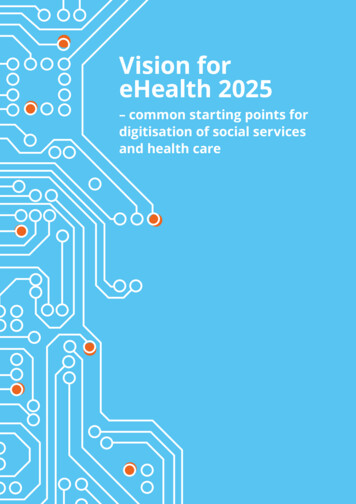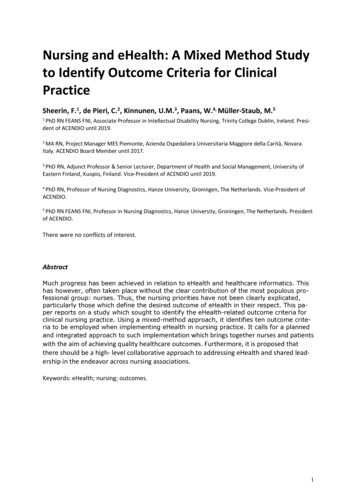
Transcription
Vision foreHealth 2025– common starting points fordigitisation of social servicesand health care1
ContentsForeword3Introduction5Earlier national initiatives in the area7The next step: A vision for eHealth activitiesConcepts used in the workVision for eHealth 2025Perspectives, principles and target groupsHow will the target groups be affected by work on the vision?The parties commitmentsDivision of responsibilitiesAreas for action99910101313132
ForewordDigitisation offers great opportunities for future social services and health andmedical care. Modern information and communication technologies can makeit easier for individuals to be involved in their own health and social care, supportcontact between individuals and service providers, and provide more efficientsupport systems for staff at service providers.The Government and the Swedish Association of Local Authorities and Regionswant to support efforts to make use of the opportunities of digitisation in socialservices and health care, and have now decided to endorse a common vision foreHealth up to 2025.In 2025, Sweden will be best in the world at using the opportunities offered by digitisation andeHealth to make it easier for people to achieve good and equal health and welfare, and to developand strengthen their own resources for increased independence and participation in the life of society.Many activities are under way at various levels related to digitisation and eHealth,and it is very important that various actors work together to make better use ofthe potential available in the area of eHealth in the long and short term. An integrated vision for eHealth can contribute to equitable, gender-equal and efficienthealth care and social services that are also user-friendly, accessible and safe forindividuals.Stockholm, March 2016For central government, represented bythe Ministry of Health and Social AffairsFor the Swedish Association ofLocal Authorities and RegionsGabriel Wikström,Minister for Health Care, Public Healthand SportLena MickoChairÅsa RegnérMinister for Children, the Elderly andGender Equality3
“ Social services andhealth care are areasof welfare in whichdigitisation presentsgreat opportunities.”4
IntroductionNever before has technology offered such opportunities tomanage and use information and communication technologies.In many areas of society, digitisation has already generatedradical changes in the ways in which people meet and interact.To give a few examples, thanks to digitisation meetings with clients in the travelindustry and the banking sector and meetings with citizens in public administration have largely moved from physical premises to people’s homes. As a result,people can now contact government authorities or purchase goods whenever itsuits them best. There are no indications that this trend will tail off.Sweden has good prospects of benefiting from the potential of digitisation.The country’s inhabitants are among the most digitally mature in the world, andthe business and public sectors have largely digitised their activities. Moreover,Sweden has world-leading information and communication companies, whichhave propelled international progress in the field.Social services and health care are areas of welfare in which digitisation presents great opportunities. These sectors account for a large part of public expenditure and are also sectors that most people come into contact with at one timeor another. Digitisation offers the target groups for social services and healthcare new tools and possibilities to live independently and participate in and influence society. The great majority of people want to be independent and to participate, and to have influence and control over issues and decisions that concerntheir health and their social situation. To meet these needs, tools are required forcommunication within and between services, and between services and users,clients and patients. Digitisation brings good opportunities to improve measuresrelating to children, young people, elderly people and people with disabilities.Digitisation offers new means of communication for people who have difficulties expressing their views, which can enhance participation and self-determination, as decisions can be taken in consultation with the person concerned to agreater extent. It is important that digitisation and the development of ITsupport are non-discriminatory and respond to the needs of different groups.Fundamentally, it is a matter of supporting an individualised approach, whereservices make use of and are based on the individual’s resources, leading tobetter health outcomes, increased participation and more efficient services.Digitisation is also a tool for operational development, ranging from staff access to the right information when dealing with users, clients or patients, to dataprocessing for purposes of follow-up and service performance comparisons.Opportunities also open up for staff and entrepreneurs to create new tools thatcan make services more efficient, contribute to new and innovative methods,improve procedures and increase opportunities for research and development.5
” For future work oneHealth, relevantactors in the socialservices and healthcare need a morelong-term commonapproach.”6
Earlier nationalinitiatives in the areaNational guidance and policy documents relating to digitisationin the social services and health care have existed for a numberof years. The first eHealth strategy was adopted in 20061 andwas updated in 2010 2.The concept of eHealth was first used in the latest strategy, which also includedthe full range of social services. Various types of actions have been taken in thecontext of the strategies, and these have influenced the development of eHealthover the years. Now, when almost a decade has passed, the services and the environment in which they operate have evolved and changed. Sweden continuesto need national action in the field of eHealth so as to benefit from and coordinatethe work done by all actors. For future work on eHealth, relevant actors in thesocial services and health care need a more long-term common approach anda more clearly defined division of responsibilities.1 National Strategy for eHealth (Govt Communication 2005/06:139).2 National eHealth: the strategy for accessible and secure information in health and social care.7
” In 2025, Sweden willbe best in the worldat using the opportunities offered by digitisation and eHealthto make it easier forpeople to achieve goodand equal health andwelfare.”8
The next step:A vision foreHealth activitiesAs a point of departure for continued development work in thefield of eHealth, the Government and the Swedish Association ofLocal Authorities and Regions have decided to endorse a common vision for eHealth activities until 2025.The vision replaces the latest strategy from 2010, while continuing to build onthe ideas and approaches that it contains. The intention is that the vision will befollowed by one or more action plans clarifying actions that can contribute toachieving the vision.Concepts used in the workThe concept of eHealth is used in the same way as in the latest strategy, i.e. itcovers in a broad sense the use of information and communication technologiesin relation to health as defined by the World Health Organisation (”a state of complete physical, mental and social well-being”). In this context, the concept ofeHealth includes all social services conducted by central or local government orby private actors, all health care and, to the extent relevant, dental care. Anotherconcept used in the work is digitisation. This concept covers the digitisation ofinformation, i.e. the process by which analogue information is converted intodigital format, and the digitisation of society, i.e. the broader process in societyby which various forms of IT support are integrated ever more closely into services and fundamentally influence them. A concept that is closely connectedwith eHealth and digitisation, and sometimes partly overlaps them, is welfaretechnology. This is defined as knowledge about and use of technology that cancontribute to increased security, activity, participation and independence forindividuals with disabilities of all ages and their families. This concept will beincluded in future work related to the vision.Vision for eHealth 2025In 2025, Sweden will be best in the world at using the opportunities offered by digitisation andeHealth to make it easier for people to achieve good and equal health and welfare, and to developand strengthen their own resources for increased independence and participation in the life ofsociety.Increased digitisation provides effective operational support to ensure highquality social services, health care and dental care. To lay the foundation for thiswork, relevant actors need to create necessary conditions for their services to usethe opportunities offered by digital progress both in day-to-day activities and inlong-term improvement and development.9
Perspectives, principles and target groupsThe work on the vision is to be pursued on the basis of a number of fundamental perspectives and principles deriving largely from the legislation and otherregulations governing the services.Equality is a fundamental principle of social services and health care. One aspectof this is that people who live in different socio-economic circumstances shouldhave equal access to support according to their needs and are to be treated onthe basis of their own personal position. By making tools available that supportactions tailored to the users’, clients’ and patients’ individual needs, digitisationcan make it easier for the services to work for increased equality. Digitisationalso improves possibilities for follow-up and analysis of unjustified differencesbetween outcomes in different services.A gender perspective is to be applied in the work on digitisation and eHealthto ensure equal services, resource distribution and influence for girls and boys,women and men. The work must also bear in mind the protection of individualsagainst invasion of their personal privacy, the need for confidential access management relating to personal data, and issues of consent.Efficiency is another fundamental principle of social services and health care.Increased efficiency for long-term, sustainable health care and social services isessential to manage the challenges posed by an ageing population and growingexpectations.In addition to these perspectives, the work is also to proceed on the basis of anumber of fundamental principles such as accessibility, usability and digital participation, as well as protection of privacy and information security. As far aspossible, digital services are to be designed for universal use, in accordance withthe ‘design for all’ concept, which means that IT support should be available toand usable by all people, irrespective of age, disability, level of knowledge andother conditions, without any need for adaptation or special design.The 2010 eHealth strategy identified three main target groups: individuals, healthand care service staff, and decision-makers. In the process towards achieving thevision, special emphasis should be given to the first two groups, while broadening the scope beyond just health and social care to include all social services, allhealth care and, to the extent relevant, dental care. In addition, a child and youthperspective should be applied, as this is a group whose position can be strengthened with the help of various types of IT support. The 2010 strategy affirmedthe potential of other actors, such as private and non-profit entrepreneurs, andthe research community, to contribute to development. As in the previous strategy, these actors must be involved in the future work of giving the vision concrete form.How will the target groups be affected by work on the vision?The aim of the vision is that digitisation and eHealth will make it easier for peopleto achieve good health and welfare, and develop and strengthen resources for increased independence and participation in the life of society. This involves usingvarious types of IT support to activate users’, clients’ and patients’ own resourcesin order to achieve important values such as improved health and increased participation and self-determination. Access to information concerning themselves,individually tailored digital support and smooth lines of communication enable10
people to take greater control over their health and life situation. For peoplewith an impaired ability to make decisions, welfare technology can be a tool forincreased participation and self-determination, while enabling responsibleentities to use resources more efficiently. In addition, access to social servicesand health care can be improved by digital solutions that enable people to contact services irrespective of distance and to receive support and help from home.Digital solutions can also increase opportunities for families to participate bymaking it easier for them to communicate with services or obtain informationconcerning a family member.In order to fulfill the vision it is important that sufficient support is providedto the staff to enable them to offer high-quality social services and health care.At an overarching level this means creating a supportive digital working environment. Digitisation also contributes to the development of new career paths asnew and different types of needs or services arise. This can be an attractive factorfor the long-term skills supply. Digitisation can also promote a better workingenvironment for the women and men employed in these services. One fundamental condition for achieving this is access to effective tools for documentation,as well as knowledge and decision-making support to guarantee high quality andsecurity while facilitating day-to-day work.A fundamental prerequisite for being able to use the possibilities that digitisationoffers to the full is that skills to deal with IT systems exist at all levels in the services. To lay the foundation for the work, relevant decision-makers need to createthe necessary conditions for social services and health care to use the opportunities offered by digitisation both in day-to-day activities and in long-term improvement and development. As far as possible, and wherever relevant, digital solutionsshould be the first choice when information is managed in these services. In thiscontext, ‘conditions’ should be interpreted broadly. ‘Conditions’ can be a matterof ensuring that human and operational resources are available, adopting legislation or other types of regulations, or deciding on the division of responsibilitiesbetween different actors.Sweden has a strong IT sector that contributes to economic growth and employment. The innovative potential of social services and health care, and of the lifescience sector as a whole, should be taken into account in the future process ofachieving the vision. The business sector can also contribute in various waysin developing services and making them more efficient, while identifying newbusiness opportunities that can generate growth and new jobs. The developmentof eHealth is high on the international agenda and has been identified by theEU as one of the strongest areas of growth in Europe. Sweden has a role to playin this process.11
” eHealth is theresponsibility ofmany actors.”12
The partiescommitmentsTo achievehe vision, the parties, i.e. the Government and theSwedish Association of Local Authorities and Regions (SALAR),intend to work together for the implementation of a numberof actions.The approach that was established in the first strategy from 2006, that eHealthis the responsibility of many actors, remains in effect. With regard to the overalldivision of responsibilities, municipalities and county councils (local authoritiesand regions) have the main responsibility for social services and health care. Thisresponsibility means organising, directing, planning, developing, quality-assuringand financing services. The responsibilities of central government primarily concern legislation, supervision, the local government equalisation system and allocation of grants. There is also a general responsibility to establish objectives andrequirements regarding the quality and availability of public services such as socialservices and health care, and to monitor compliance with these.To solve the challenges the social services and health care face in a safe and efficient way, the public sector needs to cooperate with other actors. These consistof professional associations in various occupational categories, organisationsrepresenting private and non-profit providers, entrepreneurs and organisationsrepresenting patient, user and family organisations, the industry and others.Division of responsibilitiesIn the process ahead, the parties intend to maintain and, where necessary, deepencooperation and collaboration between relevant actors.Further, the parties intend to work for a more clearly defined division of responsibilities between central and local government. The broad division of responsibilities has been described above and this applies in the field of eHealth as well.Currently, there are activities in the eHealth field where several different actorsoperate in parallel. The ambition in the process ahead s to clarify who does whatand ensure effective coordination. Furthermore, the parties’ ambition is thatnew actions or proposals, where possible with reference to the existing divisionof responsibilities, will be analysed from the perspective that the organisationor actor best suited to taking care of the action will also be responsible for it.Actions will focus on creating the fundamental conditions and forms of governance needed to harness the potential of digitisation and to guarantee nationalinterests in equal standards of service throughout the country.Areas for actionA number of areas are particularly important for the parties to focus on in futurework to enable the vision to be realised. These are regulatory frameworks, moreconsistent use of terms and standardisation issues.13
The starting point in the work on regulatory frameworks in the eHealth field isto strike a balance between rights or interests such as protection of privacy, quality,safety and efficiency. The legislation and other regulations governing activitiesmust guarantee the various rights or interests of the individual. The regulatoryframework should address technical developments. If the regulatory frameworkneeds to be changed for the sake of quality and efficiency of services, the needfor protection of privacy and security must also be met. The responsibility forestablishing norms lies with central government, and SALAR works to supportthe work of municipalities and county councils in complying with existing legislation and implementing new or amended legislation in their services.With regard to more consistent use of terms, this is a matter of ensuring thatcodes, concepts, terms and structures used are valid and usable in the work ofresponsible entities to enable the exchange of information that is needed toguarantee quality and security. Data should be structured in such a way that theservices can analyse and draw conclusions about the outcomes of actions overtime, comparing different actors and different processes and forms of treatment.The Government should work to provide the responsible entities with nationalsupport in their work. SALAR should work to ensure that municipalities andcounty councils, where warranted, cooperate among themselves and with relevant central government actors in implementing common concepts, termsand classifications or structures in their services.To make it technically possible to exchange information while ensuring qualityand security, standards are needed. This applies, for example, to common nationalspecifications and services for secure authorisation and processes. Further, technical standards are a precondition for interoperability between different actors andinterchangeability between different components. This is a broad field and Swedenis very much affected by work conducted in many international organisations.Here the Government and SALAR share responsibility. The Government’s primary role is to work to ensure that national and international standardisationefforts linked to social services and health care can be implemented smoothly,while SALAR’s role is to seek to ensure that municipalities and county councilsintroduce agreed standards in their systems.14
The Government adopted this vision on 10 March 2016(S2016/01874/FS) Artikelnr: S2016.01215
16
the potential available in the area of eHealth in the long and short term. An inte- grated vision for eHealth can contribute to equitable, gender-equal and efficient . and usable by all people, irrespective of age, disability, level of knowledge and other conditions, without any need for adaptation or special design.










